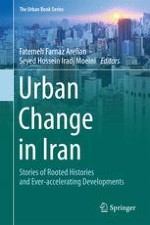2016 | OriginalPaper | Chapter
2. The Role of Qanat and Irrigation Networks in the Process of City Formation and Evolution in the Central Plateau of Iran, the Case of Sabzevar
Authors : Hassan Estaji, Karin Raith
Published in: Urban Change in Iran
Publisher: Springer International Publishing
Activate our intelligent search to find suitable subject content or patents.
Select sections of text to find matching patents with Artificial Intelligence. powered by
Select sections of text to find additional relevant content using AI-assisted search. powered by
